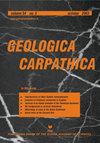Integrated bio- and cyclostratigraphy of Middle Triassic (Anisian) ramp deposits, NW Bulgaria
IF 1.5
4区 地球科学
Q4 GEOSCIENCES, MULTIDISCIPLINARY
引用次数: 4
Abstract
Abstract A cyclostratigraphic interpretation of peritidal to shallow-marine ramp deposits of the early Middle Triassic (Anisian) Opletnya Member exposed in outcrops along the Iskar River gorge, NW Bulgaria, is presented. Based on facies trends and bounding surfaces, depositional sequences of several orders can be identified. New biostratigraphic data provide a time frame of the studied succession with placement of the boundaries of the Anisian substages and show that the Aegean (early Anisian) substage lasted about 1.6 Myr. In the corresponding interval in the two studied sections, 80 elementary sequences are counted. Five elementary sequences compose a small-scale sequence. The prominent cyclic pattern of the Opletnya Member can thus be interpreted in terms of Milankovitch cyclicity: elementary sequences represent the precession (20-kyr) cycle and small-scale sequences the short eccentricity (100-kyr) cycle in the Milankovitch frequency band. Medium-scale sequences are defined based on lithology but only in two cases can be attributed to the long eccentricity cycle of 405 kyr. The transgressive-regressive facies trends within the sequences of all scales imply that they were controlled by sea-level changes, and that these were in tune with the climate changes induced by the orbital cycles. However, the complexity of facies and sedimentary structures seen in the Opletnya Member also implies that additional factors such as lateral migration of sediment bodies across the ramp were active. In addition, three major sequence boundaries have been identified in the studied sections, which can be correlated with the boundaries Ol4, An1, and An2 of the Tethyan realm.保加利亚西北部中三叠纪(阿尼斯阶)斜坡矿床的综合生物和旋回地层学
摘要对保加利亚西北部Iskar河峡谷露头中早三叠世(Anisian) Opletnya段的潮外-浅海斜坡沉积进行了旋回地层解释。根据相走向和边界面,可以识别出不同阶的沉积层序。新的生物地层资料提供了研究演替的时间框架和安尼西亚亚阶段的边界位置,并表明爱琴海(早期安尼西亚)亚阶段持续约1.6亿古。在两个研究区段对应的区间内,共计算出80个初等序列。五个初等序列组成一个小尺度序列。Opletnya段突出的旋回模式可以用Milankovitch旋回来解释:在Milankovitch频带内,初级层序代表进动(20 kyr)旋回,小尺度层序代表短偏心(100 kyr)旋回。中等规模的层序是根据岩性来定义的,但只有两种情况可以归因于405 kyr的长偏心旋回。各尺度层序内的海侵—海退相趋势表明,海侵—海退相受海平面变化控制,与轨道旋回引起的气候变化一致。然而,在Opletnya段看到的相和沉积构造的复杂性也意味着其他因素,如沉积物体在斜坡上的横向迁移也很活跃。此外,研究剖面确定了3个主要层序边界,可与特提斯领域的Ol4、An1和An2边界相对应。
本文章由计算机程序翻译,如有差异,请以英文原文为准。
求助全文
约1分钟内获得全文
求助全文
来源期刊

Geologica Carpathica
地学-地球科学综合
CiteScore
2.40
自引率
23.10%
发文量
26
审稿时长
>12 weeks
期刊介绍:
GEOLOGICA CARPATHICA covers a wide spectrum of geological disciplines including geodynamics, tectonics and structural geology, volcanology, stratigraphy, geochronology and isotopic geology, karstology, geochemistry, mineralogy, petrology, lithology and sedimentology, paleogeography, paleoecology, paleobiology and paleontology, paleomagnetism, magnetostratigraphy and other branches of applied geophysics, economic and environmental geology, experimental and theoretical geoscientific studies. Geologica Carpathica , with its 60 year old tradition, presents high-quality research papers devoted to all aspects not only of the Alpine-Carpathian-Balkanian geoscience but also with adjacent regions originated from the Mediterranean Tethys and its continental foreland. Geologica Carpathica is an Official Journal of the Carpathian-Balkan Geological Association.
 求助内容:
求助内容: 应助结果提醒方式:
应助结果提醒方式:


